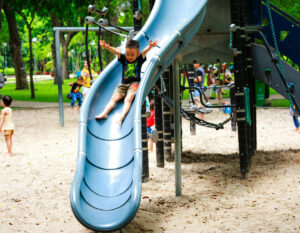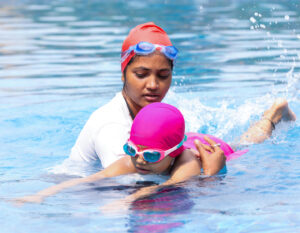
Hone what you do and how you do it.
Parents have a world of influence over their children’s development. That’s why researchers have been studying parenting styles for decades! Parenting styles refer to the sets of attitudes and behaviours that parents consistently adopt when interacting with and managing their children, which in turn creates the emotional context that their children grow up in (Darling & Steinberg, 1993). In other words, parenting styles can be thought of as general approaches to raising children that encompass not just what parents do but how they do it.
There are so many variations and terminologies out there. Sometimes, it can be hard to know which direction to take – you might opt to pick and choose advice from different styles to find something that fits (this may be something you already do instinctively and are happy with). If you’re looking for some guidance and want to know more from child development experts, take a look at four of the most distinct parenting styles. See if they sound familiar and which one might work for you as each one has its own merits. Happy parenting!
Read more: A Hong Kong Mama Explains How She ‘Raised’ Her Parenting Style From Bulldozer To Drone

1. Authoritative Parenting
As the name suggests, the authoritative parent is one who commands respect and is trustworthy. Coined by developmental psychologist Diana Baumrind in the 1960s, authoritative parenting is one of the most studied parenting styles to date. Baumrind (1966) saw parents as authority figures to their children who have the power to influence their actions and character.
What does it look like?
Authoritative parents value discipline and conformity, at the same time, respect their children’s autonomy and independence. They do not rule with an iron fist but encourage cooperation through reason, which is why you will more likely hear them say, “let’s discuss this” than “because I said so”. They are also characterised as demanding and responsive in that they set high but reasonable standards for their children’s behaviours and provide enough support for them to succeed. In short, these are the parents who are firm but warm and are more like a mentor than a friend or an autocrat to their children. Practices may include:
- Setting high but age-appropriate standards for behaviours
- Allowing freedom within reasonable limits
- Using reasoning to explain limits, rules, and consequences for appropriate and inappropriate behaviours
- Monitoring and disciplining fairly and consistently using non-punitive measures
- Communicating with warmth and respect
- Being nurturing and involved in children’s life
- Encouraging children to express opinions and feelings
- Listening to children and having give-and-take discussions
- Encouraging children to think for themselves and providing emotional support
What are the benefits?
This balanced approach combining structure with warmth and guidance has consistently been associated with positive outcomes in children and adolescents in studies across cultures (Steinberg, 2001). In general, those with authoritative parents tend to be more confident, independent, self-reliant, well-adjusted, perform better academically, have fewer behavioural problems and are less likely to engage in delinquent behaviours and drug use. With that said, this is certainly not the only sound parenting style out there!
Read more: Raising Resilient Hong Kong Kids By Teaching Them Happiness
2. Unconditional Parenting
Wouldn’t it be nice to know that you are loved unconditionally, accepted for who you are, regardless of what you do? This is the message those practising unconditional parenting strive to convey to their children, hence the name. Coined by author and lecturer Alfie Kohn, unconditional parenting is based on the ideas of the humanistic psychologist, Carl Rogers. Rogers (1959) believed that unconditional positive regard from others, especially from parents during the early years of life, contributes to healthy self-worth and is one of the core conditions to nurture growth.
What does it look like?
At the heart of unconditional parenting is the expression of unconditional love. Thus, those adopting this approach avoid discipline techniques like punishing or rewarding behaviours that convey to their children the message that they are only loved when they behave in specific ways. Instead of focusing on “how can we get kids to do what they’re told,” the unconditional parenting style asks, “what do kids need, and how can we meet those needs?” (Kohn, 2005). Parents are encouraged to imagine how things look from their children’s point of view and think of ideas to work with them (e.g., asking questions and offering choices) rather than doing things to them (e.g., taking things away) to help them become caring and responsible people. Guiding principles include:
- Reflect on your parenting behaviours
- Reconsider whether your demands are reasonable or even necessary
- Stay focused on long-term goals
- Put your relationship with your children first
- Change how you see things not just how you act
- Take your children seriously and treat them with respect
- Be authentic and apologise for your mistakes
- Talk less, ask more and listen
- Be mindful of your children’s age and what they can and cannot do
- Assume the best in your children
- Pick your battle, try to say yes when you can
- Don’t be rigid
- Try to avoid being in a hurry
What are the benefits?
The unconditional parenting approach is nothing short of a paradigm shift, but it is not without its benefits. It has been found that children’s perception of unconditional acceptance from a parent is predictive of their own unconditional self-acceptance, which is, in turn, associated with their motivation for self-improvement (Tsang, 2019). Children who grow up with unconditional positive regard from their parents are also associated with lower psychological complaints (Lopes, van Putten, & Moormann, 2015), more likely to try new things, and less afraid of failing.
Read more: Things You’ll Do Differently As A Second-Time Mum

3. Attachment Parenting
Attachment parenting, coined by paediatrician William Sears, is a child-rearing approach intended to forge strong bonds between parents and children. It borrowed its name from the seminal work on attachment theory developed by psychologist and psychoanalyst John Bowlby (1969), who described attachment as a deep and lasting emotional bond that connects two people, first formed between an infant and caregiver. This early attachment is how an infant’s basic needs for comfort, protection, and food are met and further influences his/her social, emotional, and cognitive development.
What does it look like?
It is this bond that attachment parenting aims to foster from the moment of birth so that parents can attune to and care for their children’s needs more readily (Sears & Sears, 2001). To this end, the attachment parenting style emphasizes nurturing through physical closeness and touch and encourages practices such as skin-to-skin contact, babywearing and co-sleeping. Another cornerstone of this approach is sensitive and responsive parenting in that parents learn to read their children’s signals accurately and provide appropriate responses to meet their needs with the view that doing so facilitates their development of trust and independence rather than spoils them. Attachment parenting is thus an approach that adapts to children’s individual needs and has no set rules. Practices may include:
- Birth bonding e.g. skin-to-skin contact with newborn
- Breastfeeding and feeding on cue
- Babywearing or holding baby frequently
- Co-sleeping
- Reading and responding to baby’s cues including cries
- Trusting your instincts and baby’s cues e.g. scheduling around baby’s natural inner rhythms
- Balancing everyone’s needs including your own and setting boundaries e.g. knowing when to say “no”
What are the benefits?
This increasingly popular approach does have its merits. Practices like skin-to-skin contact, co-sleeping, and being warm and sensitive, have been associated with lowered stress reactivity in babies or found to protect them from the effects of stress. Babywearing and especially sensitive and responsive parenting (Miller & Commons, 2010), have also been shown to relate to secure attachment and securely attached children are associated with a range of positive outcomes such as being socially competent, empathetic, positive, persistent in problem-solving and flexible in challenging situations, just to name a few.
Read more: How To Raise A Well-Rounded Only Child In Hong Kong
4. Slow Parenting
If the idea of slowing down in this fast-paced day and age appeals to you, then the approach of slow parenting might just be your cup of tea! Coined by journalist Carl Honoré, slow parenting is a part of the broader slow movement and is a response against the widespread trend in modern-day parenting that keeps children occupied with jam-packed schedules of afterschool and weekend activities.
What does it look like?
As an approach, slow parenting sees parenting as a journey not to be forced or rushed through. It encourages parents to step back in a measured and caring manner to let children work out who they are instead of who others want them to be and allow things to naturally unfold while providing them with unconditional love and attention. It also emphasises quality over quantity, developing real and meaningful human connections and being present and engaged in the moment. Parents adopting this approach make conscious effort to organise fewer activities for their children so that the family may have more time to rest, reflect, and spend time together. At the same time, children are given more time and space to play freely and explore the world at their own pace. Practices may include:
- Encouraging children to explore their creativity
- Limiting TV time
- Encouraging more time in nature
- Scheduling fewer activities
- Taking a step back and allowing room for risks
- Being mindful but not intrusive
- Listening and being present
- Encouraging free play
What are the benefits?
By slowing down and stepping back, parents allow children more time and freedom for leisure and play, the importance of which cannot be overemphasised. Active leisure, like physical activity, has been associated with well-being in children. At the same time, free play is known to help children develop imagination, dexterity, problem-solving skills, confidence and decision-making skills, not to mention, buffer against toxic stress (American Academy of Pediatrics, 2018). In a way, the slow parenting approach can be seen as offering children more by giving them less.
Trying your best is all that matters
All parents want the best for their children, but as all children (and their parents) are unique, there’s no one “correct” or “best” approach when it comes to parenting. In fact, the fit between parenting style and a child’s temperament and developmental stage can be critical. At the same time, parenting style only represents one of many influences over a child’s life (Maccoby, 2000). Finally, those feeling the pressure to be the perfect parent may find comfort in the words of the renowned paediatrician and psychoanalyst Donald Winnicott (1953), who reminds us that it is more important just to be a “good enough” parent as the gradual “failure to adapt to every need of the child helps them adapt to external realities.”
 View All
View All









 View All
View All





 View All
View All


 View All
View All













